Procter & Gamble Bundle
Can Procter & Gamble Maintain Its Reign in the Consumer Goods Industry?
Procter & Gamble (P&G), a titan in the consumer goods industry, has consistently demonstrated its ability to adapt and thrive. Its strategic shifts, such as streamlining its brand portfolio, showcase a commitment to focusing on high-growth categories. This strategic agility is crucial for navigating the complexities of the global market and ensuring sustained success.
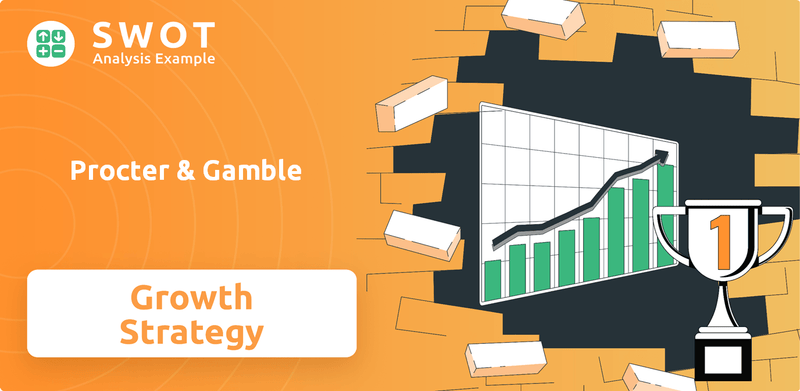
From its humble beginnings in 1837, Procter & Gamble SWOT Analysis has evolved into a multinational powerhouse, selling its products worldwide. This exploration will dissect P&G's growth strategy, examining its expansion initiatives, innovation, and financial management. We'll also analyze P&G's future prospects, considering market dynamics and the company's ability to adapt to changing consumer behaviors, and the competitive landscape within the consumer goods industry.
How Is Procter & Gamble Expanding Its Reach?
The growth strategy of the company, heavily relies on a multi-faceted approach to expansion. This includes geographical market penetration, product portfolio diversification, and strategic mergers and acquisitions. The company's focus is on high-growth, high-margin areas, particularly within its core product categories.
A key element of this strategy is premiumization, offering higher-value products to meet evolving consumer demands. Furthermore, the company remains open to strategic acquisitions to complement its existing portfolio and accelerate entry into new segments. The company's organic sales growth for fiscal year 2024 is projected to be in the range of 4% to 5%, indicating continued momentum in its expansion efforts.
The company's strategy includes a strong focus on emerging markets. These markets offer significant untapped potential due to rising disposable incomes and growing populations. The company tailors its product offerings to local preferences and expands its distribution networks to reach new consumers. For example, the company has been expanding its presence in Latin America, India, the Middle East, and Africa to capture new consumers and drive category growth. For more information, check out the Mission, Vision & Core Values of Procter & Gamble.
The company prioritizes growth in developing markets, such as Latin America, India, the Middle East, and Africa. This involves adapting product offerings to local preferences and expanding distribution networks. The goal is to capture new consumers and drive category growth within these regions.
The company consistently launches new products and line extensions within its core categories. This strategy leverages its deep consumer insights and R&D capabilities. Premiumization, offering higher-value products, is a key element to meet evolving consumer demands.
The company remains open to strategic acquisitions that complement its existing portfolio. This approach accelerates entry into attractive new segments or technologies. The focus is on enhancing the company's overall market position and growth potential.
The company concentrates on its 10 product categories, which represent around 80% of its sales and 90% of its after-tax profit. This strategy emphasizes high-growth, high-margin areas. This focused approach helps drive revenue growth and profitability.
The company's expansion strategy involves multiple initiatives. These initiatives are designed to drive growth and increase market share. The company's focus is on both organic growth and strategic acquisitions.
- Expanding into emerging markets with tailored products.
- Launching new products and line extensions within core categories.
- Focusing on premiumization to meet consumer demands.
- Strategic acquisitions to complement the existing portfolio.
Procter & Gamble SWOT Analysis
- Complete SWOT Breakdown
- Fully Customizable
- Editable in Excel & Word
- Professional Formatting
- Investor-Ready Format
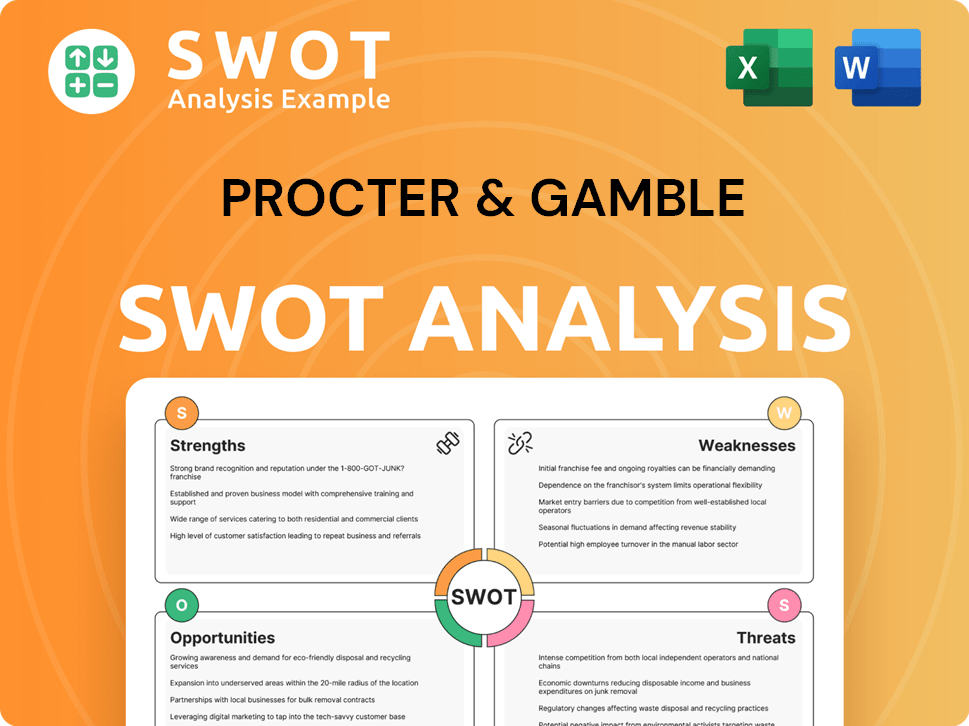
How Does Procter & Gamble Invest in Innovation?
The growth strategy of Procter & Gamble (P&G) is significantly shaped by its commitment to innovation and the integration of advanced technologies. This approach is crucial for maintaining its competitive edge in the consumer goods industry. P&G's future prospects are closely tied to its ability to adapt and excel in these areas, ensuring it meets evolving consumer needs and preferences.
P&G's focus on innovation helps it develop new products and improve existing ones, which is essential for driving sales and increasing market share. The company's investment in digital transformation further enhances its operational efficiency and consumer engagement. This strategic alignment allows P&G to stay relevant and responsive in a dynamic market environment.
P&G invests heavily in research and development (R&D) to fuel its innovation pipeline. This includes both internal efforts and collaborations with external partners. For instance, the beauty segment, with brands like SK-II, continues to experience significant sales growth through innovative product offerings. This dedication to R&D is a cornerstone of the company's strategy to maintain a competitive advantage.
P&G allocates a substantial portion of its resources to research and development. This investment supports the creation of new products and the improvement of existing ones, driving growth. In fiscal year 2023, P&G's R&D expenses were approximately $2.2 billion.
Digital transformation is a key focus, with P&G actively embracing automation, data analytics, and AI across its operations. This includes supply chain optimization, manufacturing, marketing, and consumer engagement. AI is used to gain deeper consumer insights and personalize product recommendations.
Sustainability is a core part of P&G's strategy, with efforts to integrate environmentally friendly practices and materials into product development and packaging. This includes developing new formulas and materials for products like Tide and Dawn. These initiatives are aimed at reducing the environmental footprint.
P&G has significantly expanded its e-commerce presence to meet changing consumer behavior. The company focuses on direct-to-consumer sales and partnerships with major online retailers. E-commerce sales continue to grow, contributing to overall revenue.
P&G leverages data analytics and AI to gain deeper insights into consumer behavior and preferences. This enables the company to personalize product recommendations and optimize advertising campaigns. Understanding consumer needs is crucial for product development.
Continuous introduction of new products and technologies across its diverse brand portfolio is a key strategy. P&G aims to address unmet consumer needs and drive market share gains through product innovation. This includes new offerings in various categories.
P&G's technological advancements and sustainability initiatives directly contribute to its growth objectives. These innovations enhance product efficacy, improve operational efficiency, and align with evolving consumer preferences for responsible brands. These efforts not only improve the products but also create a positive brand image.
- AI and Machine Learning: Used to gain consumer insights, personalize product recommendations, and optimize advertising campaigns.
- Supply Chain Optimization: Leveraging technology to improve efficiency and reduce costs in the supply chain.
- Sustainable Packaging: Developing eco-friendly packaging materials and reducing waste.
- New Product Formulas: Creating products with reduced environmental impact, like Tide and Dawn.
- E-commerce Integration: Enhancing the online shopping experience and expanding direct-to-consumer sales.
Procter & Gamble PESTLE Analysis
- Covers All 6 PESTLE Categories
- No Research Needed – Save Hours of Work
- Built by Experts, Trusted by Consultants
- Instant Download, Ready to Use
- 100% Editable, Fully Customizable
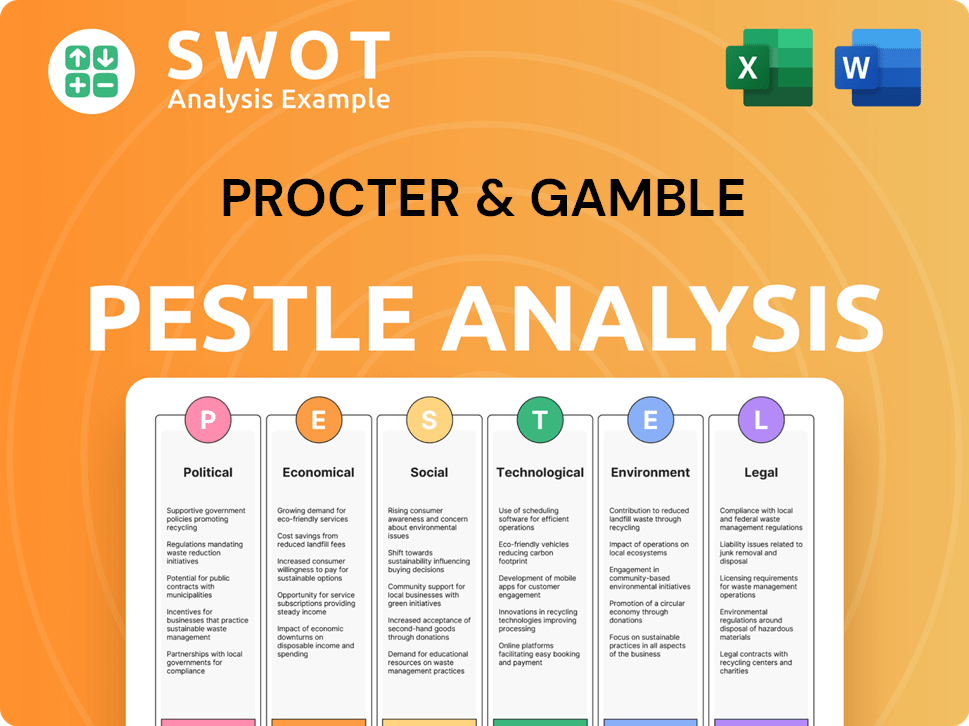
What Is Procter & Gamble’s Growth Forecast?
The financial outlook for Procter & Gamble (P&G) remains strong, reflecting consistent performance and positive projections for future growth. The company's strategic focus on its core categories and global market presence is expected to drive continued expansion. This growth is supported by a combination of strategic pricing and volume increases, demonstrating P&G's ability to adapt to market dynamics.
For fiscal year 2024, P&G anticipates organic sales growth in the range of 4% to 5%. This projection highlights the company's confidence in its ability to maintain and expand its market share. Furthermore, the company is forecasting diluted net earnings per share growth of 10% to 11% for fiscal year 2024, indicating robust profitability and financial health.
P&G's financial strategy prioritizes returning value to shareholders through dividends and share repurchases. In fiscal year 2023, P&G returned over $15 billion to shareholders, and plans to return $14 billion to $15 billion in fiscal year 2024. This consistent return of capital underscores P&G's strong cash flow generation and commitment to shareholder value, which is a key consideration for Owners & Shareholders of Procter & Gamble.
P&G's diversified portfolio of leading brands provides a stable revenue base and resilience against economic fluctuations. The company's ability to maintain strong profit margins, even in challenging economic environments, is a testament to its efficient operations and brand equity. This resilience is crucial in the competitive consumer goods industry.
P&G's long-term financial goals are underpinned by its focus on productivity improvements, cost savings initiatives, and strategic investments in innovation and market expansion. These strategies ensure sustained profitable growth. The company's commitment to innovation and efficiency is a core aspect of its business model.
P&G continues to focus on expanding its presence in emerging markets, which is a key component of its long-term growth strategy. This expansion involves tailoring products to local preferences and leveraging digital marketing to reach new consumers. The company is investing in infrastructure and distribution networks in these regions.
P&G's beauty brands are expected to remain a significant growth driver, with continued innovation in product development and marketing. The company is focusing on premiumization and personalization to meet evolving consumer demands. P&G is also investing in sustainable and eco-friendly products.
Sustainability is becoming increasingly important for P&G, with initiatives focused on reducing environmental impact and promoting ethical sourcing. These efforts are expected to enhance brand reputation and attract environmentally conscious consumers. P&G is committed to achieving its sustainability goals.
The financial performance forecast for P&G is positive, with expectations of continued revenue and earnings growth. The company's strong brand portfolio and efficient operations are expected to support these positive results. P&G's focus on shareholder returns is also a key factor.
P&G is adapting to changing consumer behavior by investing in digital marketing, e-commerce, and personalized product offerings. The company is also focused on understanding consumer preferences and trends. This adaptability is crucial for maintaining market share.
P&G's digital marketing strategy involves using data analytics, social media, and targeted advertising to reach consumers. The company is also investing in e-commerce platforms to enhance the online shopping experience. This strategy is essential for driving sales.
Procter & Gamble Business Model Canvas
- Complete 9-Block Business Model Canvas
- Effortlessly Communicate Your Business Strategy
- Investor-Ready BMC Format
- 100% Editable and Customizable
- Clear and Structured Layout
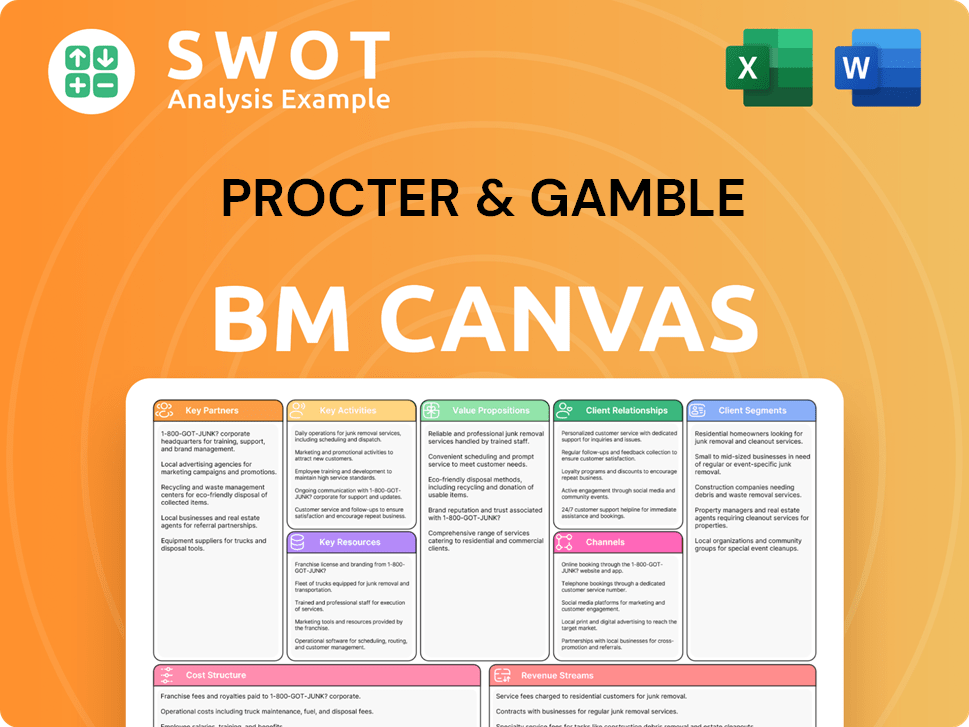
What Risks Could Slow Procter & Gamble’s Growth?
The future of Procter & Gamble (P&G) is not without its challenges. While the company holds a strong position in the consumer goods industry, several potential risks and obstacles could affect its growth trajectory. These factors require careful management and strategic foresight to ensure continued success.
Intense competition and evolving consumer preferences are key hurdles. Furthermore, P&G must navigate complex regulatory landscapes and supply chain vulnerabilities. Adapting to technological disruptions and maintaining a focus on sustainability are also critical for long-term viability.
The consumer goods market is highly competitive, with both established multinational corporations and agile local players vying for market share. This requires P&G to continually innovate and effectively market its products to retain and grow its customer base. Changing consumer preferences, such as the increasing demand for sustainable and natural products, also pose challenges. P&G must adapt its product portfolio and marketing strategies to meet these evolving needs.
Competition from both established and emerging brands remains a constant challenge. P&G must invest in innovation and marketing to maintain its market share. This includes efforts to differentiate products and build brand loyalty in a crowded marketplace.
Changes in regulations related to product safety, environmental standards, and advertising can create significant hurdles. Compliance with these regulations may require changes to product formulations, packaging, or marketing strategies. P&G must stay ahead of these changes to avoid disruptions.
Supply chain disruptions, whether from geopolitical events, climate change, or pandemics, can lead to increased costs and product shortages. Diversifying the supply chain and implementing robust risk management strategies are essential. P&G has been working to strengthen its supply chain resilience.
The rapid evolution of e-commerce and direct-to-consumer models requires continuous investment and adaptation. P&G must stay abreast of digital trends and adapt its business model accordingly. This includes optimizing its online presence and leveraging data analytics for marketing and product development.
Consumer preferences are constantly evolving, with a growing demand for sustainable, natural, and personalized products. P&G must continuously monitor these trends and adjust its product portfolio and marketing strategies to meet consumer expectations. This includes investing in research and development to create innovative products.
Localized economic downturns can impact consumer spending and demand for P&G's products. The company's global presence and diversified product portfolio help to mitigate these risks. P&G's ability to adapt to changing economic conditions is crucial for its long-term success.
P&G's growth strategy must also account for the potential impact of inflation. Rising costs of raw materials and transportation can squeeze profit margins. The company's ability to manage these costs through pricing strategies and supply chain efficiencies will be critical. P&G's financial performance forecast is closely tied to its ability to navigate these challenges.
P&G's market analysis reveals that the company faces intense competition in various product categories. Competitors include both large multinational corporations and smaller, more agile brands. To maintain its market share, P&G needs to focus on innovation, marketing, and distribution strategies. The company's ability to adapt to changing consumer preferences is also essential.
The consumer goods industry is experiencing several significant trends. These include a growing demand for sustainable and natural products, the rise of e-commerce, and the increasing importance of personalized products. P&G's success will depend on its ability to respond to these trends. The company is investing in research and development to create innovative products that meet consumer needs.
P&G's business model relies on a diversified portfolio of products sold globally. The company's revenue streams include sales of various consumer goods, such as beauty products, household cleaning supplies, and personal care items. Understanding P&G's business model is crucial for evaluating its growth strategy. You can learn more about it from Revenue Streams & Business Model of Procter & Gamble.
Inflation can significantly impact P&G's profitability by increasing the costs of raw materials, manufacturing, and distribution. The company must manage these costs through pricing strategies, supply chain optimization, and operational efficiencies. P&G's financial performance will be affected by its ability to mitigate the effects of inflation. In fiscal year 2023, P&G reported net sales of approximately $82 billion.
Procter & Gamble Porter's Five Forces Analysis
- Covers All 5 Competitive Forces in Detail
- Structured for Consultants, Students, and Founders
- 100% Editable in Microsoft Word & Excel
- Instant Digital Download – Use Immediately
- Compatible with Mac & PC – Fully Unlocked
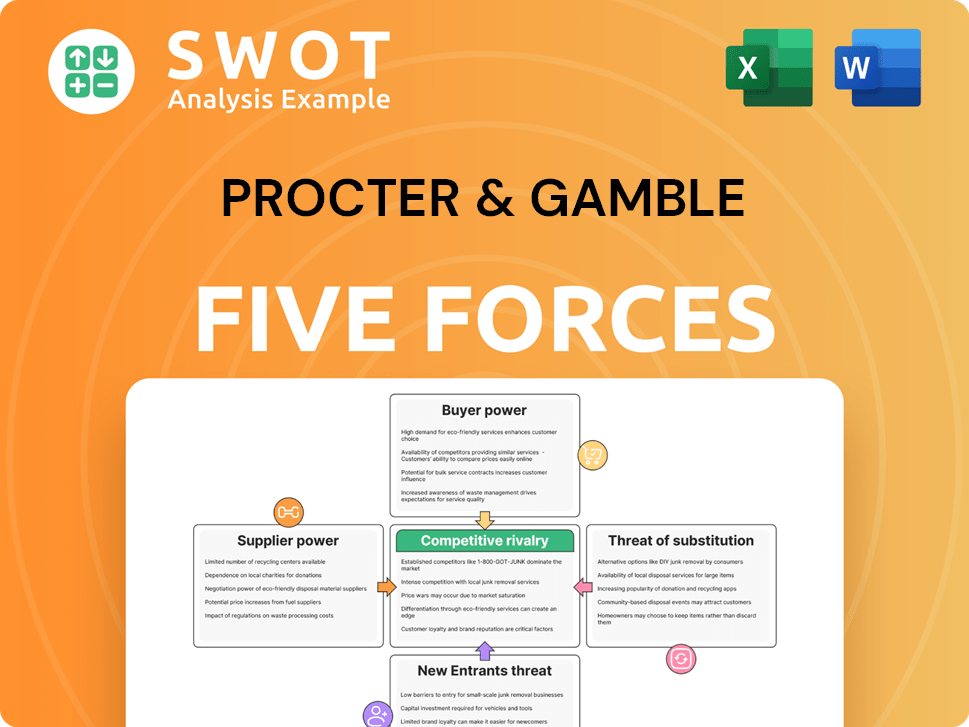
Related Blogs
- What are Mission Vision & Core Values of Procter & Gamble Company?
- What is Competitive Landscape of Procter & Gamble Company?
- How Does Procter & Gamble Company Work?
- What is Sales and Marketing Strategy of Procter & Gamble Company?
- What is Brief History of Procter & Gamble Company?
- Who Owns Procter & Gamble Company?
- What is Customer Demographics and Target Market of Procter & Gamble Company?
Disclaimer
All information, articles, and product details provided on this website are for general informational and educational purposes only. We do not claim any ownership over, nor do we intend to infringe upon, any trademarks, copyrights, logos, brand names, or other intellectual property mentioned or depicted on this site. Such intellectual property remains the property of its respective owners, and any references here are made solely for identification or informational purposes, without implying any affiliation, endorsement, or partnership.
We make no representations or warranties, express or implied, regarding the accuracy, completeness, or suitability of any content or products presented. Nothing on this website should be construed as legal, tax, investment, financial, medical, or other professional advice. In addition, no part of this site—including articles or product references—constitutes a solicitation, recommendation, endorsement, advertisement, or offer to buy or sell any securities, franchises, or other financial instruments, particularly in jurisdictions where such activity would be unlawful.
All content is of a general nature and may not address the specific circumstances of any individual or entity. It is not a substitute for professional advice or services. Any actions you take based on the information provided here are strictly at your own risk. You accept full responsibility for any decisions or outcomes arising from your use of this website and agree to release us from any liability in connection with your use of, or reliance upon, the content or products found herein.